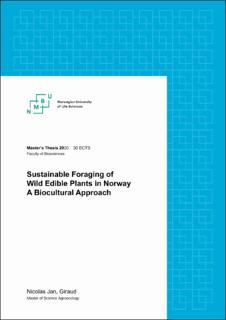| dc.contributor.advisor | Teixidor-Toneu, Irene | |
| dc.contributor.advisor | Kool, Anneleen | |
| dc.contributor.advisor | Annes, Alexis | |
| dc.contributor.advisor | Nicolaysen, Anna Marie | |
| dc.contributor.author | Giraud, Nicolas Jan | |
| dc.coverage.spatial | Norway | en_US |
| dc.date.accessioned | 2021-02-03T13:10:46Z | |
| dc.date.available | 2021-02-03T13:10:46Z | |
| dc.date.issued | 2020 | |
| dc.identifier.uri | https://hdl.handle.net/11250/2726008 | |
| dc.description.abstract | Globally, the role of wild edible plants (WEPs) in providing culturally appropriate nutrition and food security, added economic value, and ecological benefits, is now well recognized. In Europe, the use of WEPs appears both as an ancient and on-going subsistence activity, but also as an emerging trend in high-end gastronomy and luxury foods. Yet, WEPs remain underutilized and mostly neglected, and the conservation of knowledge systems and practices associated to them is threatened. It is also unknown if there are any threats on the plant populations through harvesting. In Norway, overharvesting of some wild edible species has been observed recently around urban centres. Although research has been conducted on the documentation of traditional knowledge associated to WEPs, little is known about how new foraging practices affect biological diversity. The purpose of this study was to investigate if and when foraging activities in Norway can be unsustainable and what foraging practices may threaten plant communities. Different socio-cultural constructs around WEP harvesting were analysed, notably comparing chefs and professional foragers with amateurs. In collaboration with the Norwegian Association for Mycology and Foraging, ethnographic methods were used and 19 key stakeholders were interviewed within the Norwegian foraging community including foragers, chefs, association leaders, and conservation experts. Ethnobotanical data was collected through an online questionnaire (219 responses mainly from amateur foragers), and combined with available information on species’ ecology and their conservation status to assess foraging impact on WEPs. Results show that foraging WEPs in Norway poses no immediate threat to plant conservation, yet risks exist. These are discussed in the context of developing local guidelines for the sustainable use of WEPs in Norway in a participatory manner. | en_US |
| dc.description.abstract | Le rôle des plantes sauvages comestibles est reconnu pour les nombreux services écosystémiques rendus à l’humain. En Europe, l’utilisation du sauvage comestible semble être une pratique ancestrale, liée à la pauvreté et aux situations de famines. Néanmoins, l’émergence de nouvelles cuisines gastronomiques remet le sauvage comestible au goût du jour et permettrait de promouvoir une plus grande biodiversité au sein des agroécosystèmes et dans les assiettes des consommateurs. Toutefois, cette ressource reste négligée et les systèmes de connaissances en lien avec une gestion durable subissent de nombreuses mutations. En Norvège, des situations de surexploitation ont été récemment observées. Dans ce contexte d’engouement croissant pour les produits naturels qui pousse au développement d’une économie du sauvage, il convient de se demander dans quelles mesures les activités de cueillettes sont-elles durables. Ce mémoire étudie en quoi les différents construits sociologiques et culturels influencent les comportements des cueilleurs et tente d’évaluer les impacts écologiques associés. Dix-neuf entretiens d’acteurs du domaine des cueillettes ont été réalisés pour identifier les rapports aux plantes et à la durabilité de l’activité. A l’aide d’un questionnaire en ligne (219 retours), des données ethnobotaniques ont été collectées puis combinées aux informations issues de la biologie de la conservation. La cueillette de plantes sauvages comestibles ne posent actuellement aucun problème réel. Toutefois, certaines pressions peuvent s’exercer localement sur des espèces dites populaires. Les acteurs éprouvent un besoin de se réunir afin d’élaborer par une approche participative un guide de bonnes pratiques qui permettrait d’approcher une promotion responsable de la ressource. | en_US |
| dc.description.sponsorship | Erasmus ; French Ministry of Agriculture | en_US |
| dc.language.iso | eng | en_US |
| dc.publisher | Norwegian University of Life Sciences, Ås | en_US |
| dc.rights | Attribution-NonCommercial-NoDerivatives 4.0 Internasjonal | * |
| dc.rights.uri | http://creativecommons.org/licenses/by-nc-nd/4.0/deed.no | * |
| dc.subject | Biocultural Diversity | en_US |
| dc.subject | Foraging | en_US |
| dc.subject | Sustainability | en_US |
| dc.subject | New Nordic Food Movements | en_US |
| dc.subject | Wild Edible Plants | en_US |
| dc.title | Sustainable foraging of wild edible plants in Norway : a biocultural approach | en_US |
| dc.type | Master thesis | en_US |
| dc.description.version | submittedVersion | en_US |
| dc.subject.nsi | VDP::Mathematics and natural science: 400::Zoology and botany: 480::Ecology: 488 | en_US |
| dc.relation.project | Norges forskningsråd/SAMKUL/283364/“People and Plants – Rediscovering and safeguarding Nordic ethnobotanical heritage” | en_US |
| dc.description.localcode | M-AE | en_US |

